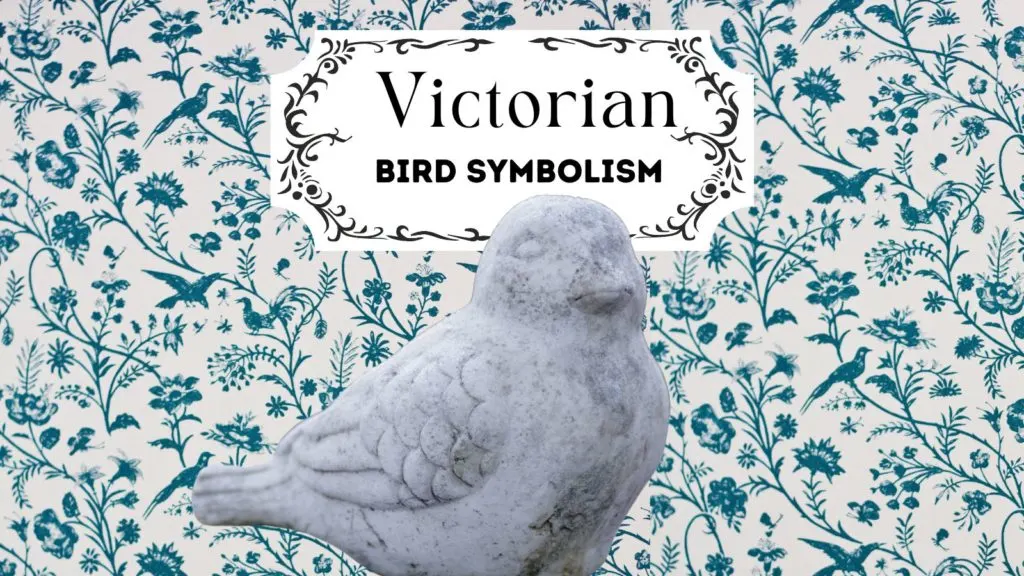It’s hard to picture the Victorian era without its rich symbolism in art, literature, and everyday life. Did you know that some of that symbolism included birds? This historical period was marked by a fascination with nature and birds were especially potent symbols, each species carrying its own array of meanings. Here’s a look at the Victorian interpretations of various bird symbols that were used in everything from heraldry to headstones to home decorations.

Doves
Doves were universally symbols of peace, purity, and love. In Victorian times, they were often associated with the Holy Spirit in Christian iconography, representing purity and divine inspiration.
A dove holding an olive branch further emphasized its meaning of peace and reconciliation.
Doves were also a popular motif in love tokens and marriage symbols, representing enduring, faithful love.
Bird Cages
In Victorian symbolism, bird cages were complex symbols. They could represent captivity or confinement but also protection. The context in which a bird cage was depicted often determined its meaning.
An open bird cage could symbolize freedom or the release of emotions and ideas, while a closed one might signify a trapped spirit or restricted freedom.
Swallows
Swallows were seen as symbols of hope and the safe return of a loved one. Because swallows migrate annually but always return home, they became associated with the idea of loyalty and fidelity.
Sailors often tattooed swallow imagery on their bodies as a promise of returning home safely.
Ravens and Crows
These birds were often associated with bad omens, death, and mysticism in Victorian symbolism, stemming from their black plumage and scavenging habits.
However, ravens and crows were also seen as protectors of the realm and keepers of secrets, embodying wisdom and guardianship.
Robins
Robins were symbols of rebirth and renewal, often associated with the arrival of spring.
Their red breasts were also linked to the Christian story of Christ’s suffering, making them emblems of sacrifice and compassion.
Peacocks
Peacocks symbolized beauty, pride, and immortality. Their expansive and colorful tail feathers represented the all-seeing eyes of the church, embodying omniscience and the beauty of the soul.
However, peacocks were also symbols of vanity and pride, demonstrating the dual nature of beauty.
Bird Feathers
Feathers in general were symbols of communication, inspiration, and freedom.
Specific feathers could have additional meanings based on their color and the bird from which they came. For example, a peacock feather could symbolize beauty and pride, while an eagle feather might represent courage and honor.
Eagles
Eagles were seen as symbols of strength, courage, and conquest. Their association with heights and the sky also made them emblems of aspiration and spiritual elevation.
In heraldry, the eagle was a common symbol of empire and leadership.
Owls
Owls symbolized wisdom, knowledge, and transition.
Because they are nocturnal, they were often associated with the mysteries of the night and the unknown. They were seen as protectors against harm and as guides to uncovering hidden truths.
Canaries and Songbirds
Canaries and other songbirds symbolized joy, music, and the sweetness of life. Their cheerful songs brought happiness and were a reminder of the beauty of the natural world.
In the Victorian language of flowers and symbols, giving someone a depiction of a songbird was a way to express joy and affection.
The Victorian era’s fascination with symbolism has left a lasting legacy, and the meanings ascribed to various birds during this time continue to influence how we perceive these creatures today. Whether as motifs in jewelry, subjects of paintings, or characters in literature, birds carry with them a rich tapestry of symbolism that speaks to the human experience across ages.
More Posts You Might Like
Mockingbird Symbolism – The Meaning of These Mimics
- 8 Letter Bird Names - August 14, 2024
- 7 Letter Bird Names - August 14, 2024
- 7 Birds Named After Famous People - July 23, 2024
